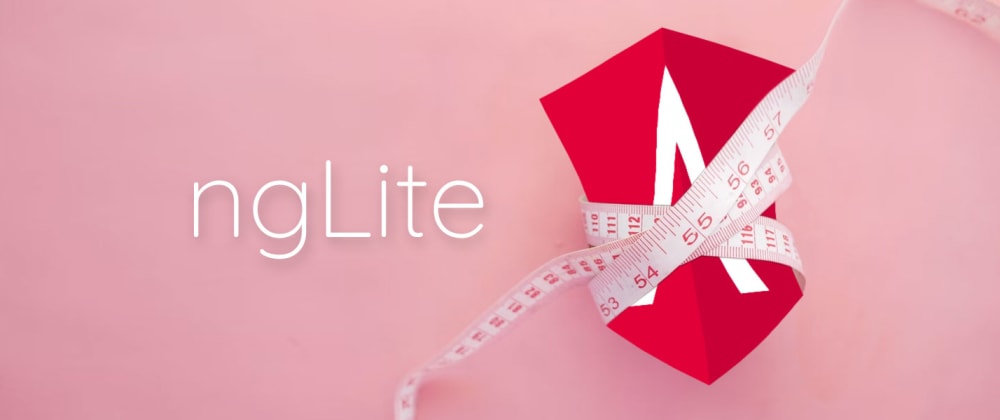A lot of complaints I heard when starting with Angular are about the sheer amount of files you get even on simple apps. When looking at the default starter template you get from Angular CLI's ng new command, it's true that it can be a bit overwhelming if you're not used to it.
But it doesn't have to always be that way. In this article, we'll explore how we can create a smaller and simpler template that's also easier to grasp for beginners, following the YAGNI principle.
Note: what we'll discuss here doesn't aim to be a new universal starter to replace the default one for all use cases, but rather an experiment on how it's possible to make things simpler.
Getting prepared
Make sure you have a recent Node.js runtime installed (at least v14), and let's start by installing the Angular CLI.
npm install -g @angular/cli
This command-line tool is used to initialize new projects, among other things. After installing, you usually use it to create a new Angular project with the ng new command, but hold off a bit!
If you're old enough, maybe you remember using nLite to slim down your Windows install, back in the day? We'll take a similar approach here with the Angular starter to create a "ngLite" template, making sure to keep the number of files to a minimum..
Note: In the following sections, we'll take some time to understand the base application template and how it can be slimmed down for simpler projects. If you want to skip directly to the end result, you can use the command
npx degit sinedied/ng-lite-starter my-appthat will use this pre-made github template, but you'll miss all the fun 😉.
Slimming down the starter template
Let's create our app with this (long) command:
ng new ng-lite --minimal --inline-template --inline-style --routing=false --style=css
Let's explain the options we used here:
-
--minimal: creates a minimal project, without any test tools. When we'll get there, we'll probably want to use a better test framework than the default one anyways. -
--inline-templateand--inline-style: enables single file components (SFC), including the HTML template and CSS styling directly into your TypeScript components. Instead of 3 files per component, you'll get only one. -
--routing=false: disables the default routing system. We can always add it back later if needed. -
--style=css: use standard CSS styling for our components. If you prefer other flavors like SCSS, you can adapt this option to suit your needs.
After the files are generated and the dependencies installed, let's hop into the ng-lite folder and start with some cleaning, removing dependencies we don't need.
cd ng-lite
# Remove the dependencies we don't need
# It's not because it's part of the framework that we have to use it :)
npm rm @angular/animations @angular/forms @angular/router @angular/platform-browser-dynamic
Now let's have a look at all the files we have:
.vscode/
|- extensions.json
|- launch.json
|- tasks.json
src/
|- app/
| |- app.component.ts
| |- app.module.ts
|- assets/
| |- .gitkeep
|- environments/
| |- environment.prod.ts
| |- environment.ts
|- favicon.ico
|- index.html
|- main.ts
|- polyfills.ts
|- styles.css
.browserslistrc
.gitignore
angular.json
package.json
README.md
tsconfig.app.json
tsconfig.json
The .vscode folder contains configurations related to the Visual Studio Code editor. It provides tasks to debug your app when pressing F5 key, and suggests you to install the must-have Angular language service extension when you open the project. If you don't use VS Code though, you can remove this folder.
Next, we'll slim down a bit the number of files at the root of the project. You can see two tsconfig.json files there, used for TypeScript configuration. This separation may be useful when you want to use a different configuration for your tests, which is the case for the default setup created by ng new, but we don't need it here. Add these lines coming from tsconfig.app.json at the bottom of the tsconfig.json file:
"files": [
"src/main.ts"
],
"include": [
"src/**/*.d.ts"
]
And remove tsconfig.app.json:
rm tsconfig.app.json
We'll need to change a bit the angular.json file before your app can build again, but let's keep that for later.
Now, there's another file that we can get rid of: .browserslistrc. It's a file that tells which browsers you want to support, and the Angular build system will adjust the CSS and JS output accordingly. Instead of having a separate file for that, you can add this entry at the end of the package.json file:
"browserslist": [
"last 1 Chrome version",
"last 1 Firefox version",
"last 2 Edge major versions",
"last 2 Safari major versions",
"last 2 iOS major versions",
"Firefox ESR"
]
Then you can remove the .browserslistrc file.
rm .browserslistrc
Reworking the src/ folder
In the src/ folder, you'll find a file named polyfills.ts that may contain polyfills, small pieces of code used to provide a compatibility layer for newer features. If you're targetting recent browsers, you can get rid of this file and just add the zone.js import at the top of main.ts:
// Add this at the top of main.ts
import 'zone.js';
Then, remove polyfills.ts:
rm src/polyfills.ts
Now, there's a folder named assets/ that you can use to put any assets (images, fonts, JSON files...) you want to be copied to the dist/ folder. It contains an empty .gitkeep to get the folder stored in the git repo, as git doesn't store empty folders. We can simplify this structure a bit, by also grouping our future assets with the base index.html and favicon file:
# Removes assets/ folder
rm -rf src/assets
# Creates a public/ folder instead
mkdir src/public
# Moves index.html and favicon.ico files into it
mv src/index.html src/favicon.ico src/public
This doesn't change much, but it's more in line with what you can find in almost all other web frameworks (React, Vue, Svelte...) and it means that you can easily add any new files to be placed at the root of the dist/ folder without having to edit angular.json every time, something we'll have to do once a bit later.
The next change we'll do here is get rid of src/app/app.module.ts. Starting with Angular 14, we can create apps using only components and that's perfect as it's all we need to get started.
⚠️ Keep in mind that Angular Standalone components are still in preview, so the API may still change in the future.
# Removes app.module.ts file
rm src/app/app.module.ts
Edit the file src/app/app.component.ts, our entry component, and add standalone: true at the top of the component properties:
@Component({
// Add the line below
standalone: true,
...
We'll finally update the entry point of the application located at src/main.ts, to bootstrap our app using our component. Replace the content of the file with this:
import 'zone.js';
import { enableProdMode } from '@angular/core';
import { bootstrapApplication } from '@angular/platform-browser';
import { AppComponent } from './app/app.component';
import { environment } from './environments/environment';
if (environment.production) {
enableProdMode();
}
bootstrapApplication(AppComponent)
.catch(err => console.error(err));
We'll keep the rest of the files as-is as they will be useful for our app:
-
src/styles.cssis the global stylesheet for the app. You can use it to import any CSS lib you want to use, and put your global styling here. -
src/environments/environment*.tsthese files contain the environment configuration for the app.environment.tswill be used during development, andenvironment.prod.tswill replace it during production builds so it's an easy way to define any environment-specific settings, like your API URL.
Editing angular.json
The angular.json file is the (rather verbose) configuration file that tells the Angular CLI how to run your project's tasks, such as building your app. Since we changed a few things from the default app structure, our final step it to update this file to reflect our changes.
Replace the line
"tsConfig": "tsconfig.app.json",with"tsConfig": "tsconfig.json",Remove the line
"polyfills": "src/polyfills.ts",Replace the line
"index": "src/index.html",with"index": "src/public/index.html",-
Replace this:
"assets": [ "src/favicon.ico", "src/assets" ],with:
"assets": [ { "glob": "**/*", "input": "src/public", "output": "." } ], -
Finally, add the line
"standalone": true,under the"@schematics/angular:component"key, as we'll use standalone components in our app:
// ... "@schematics/angular:component": { "standalone": true, // ... }
Wheew! That's a lot of changes, but we managed to simplify our starter template by quite a lot while still retaining essential Angular features. Look at this screenshot:
Also, a nice side effect of this work is the reduction of the initial bundle size, from a 150.91 kB total (46.20 kB gzipped) with the default ng new template to a 116.01 kB total (36.15 kB gzipped) with our starter.
Of course, that's a bit tedious and not something you want to do every time you start a new project! You can use this github template if you'd like to use this starter again in the future, or you can make your own.
What about testing?
You may have noticed that this template doesn't include any testing tools. This is fine for learning and personal projects, but it's not a good idea for a production app to skip unit testing.
While the default Angular starter includes unit tests, it makes use of the older and clunky Karma/Jasmine combo for unit testing.
When you need unit testing for your project, you can use the much better and faster testing framework Jest with our ngLite template by adding a few extra steps:
Run the command
npm install --save-dev jest @angular-builders/jest @types/jestto install the dependencies.-
Add a
jest.config.jsfile to your project root with the following content:
module.exports = { clearMocks: true, collectCoverage: true, coverageDirectory: "coverage", }; -
Add a
tsconfig.spec.jsonfile to your project root with the following content:
{ "extends": "./tsconfig.json", "compilerOptions": { "outDir": "./out-tsc/spec", "types": ["jest"], "esModuleInterop": true }, "include": [ "src/**/*.spec.ts", "src/**/*.d.ts" ] } -
In your
angular.jsonfile, add this after yourserveconfiguration (under thearchitectkey):
"test": { "builder": "@angular-builders/jest:run", "options": { "tsConfig": "tsconfig.spec.json" } },If you want to have tests generated by default when using the
ng generatecommand, you can also remove all the"skipTests": trueoccurrences in this file. -
Create your first test in
src/app/app.component.spec.ts:
import { ComponentFixture, TestBed } from '@angular/core/testing'; import { AppComponent } from './app.component'; describe('AppComponent', () => { let component: AppComponent; let fixture: ComponentFixture<AppComponent>; beforeEach(async () => { await TestBed.configureTestingModule({ imports: [AppComponent], }).compileComponents(); fixture = TestBed.createComponent(AppComponent); component = fixture.componentInstance; fixture.detectChanges(); }); it('should create the component', () => { expect(component).toBeTruthy(); }); });
You can now run your tests with ng test or ng test --watch.
What's next?
If you followed closely, you've seen that we didn't even include some of Angular's core libraries like @angular/forms or @angular/router. Well, that's not because you're writing an Angular app that you have to use all of the provided libraries! For sure they're convenient, and you can always add them back later if you need them, but you can also build your entire app without them.
That's what we'll explore in a further article. Now that we have a simpler starter template, why not try building a complete app, and keeping the code as simple as it can?
In the meantime, you can have a look at this todo list app built from expanding on that idea.
Follow me on Twitter, I would be happy to discuss and take your suggestions!










Oldest comments (2)
Great tutorial for beginners.
Nice thank you